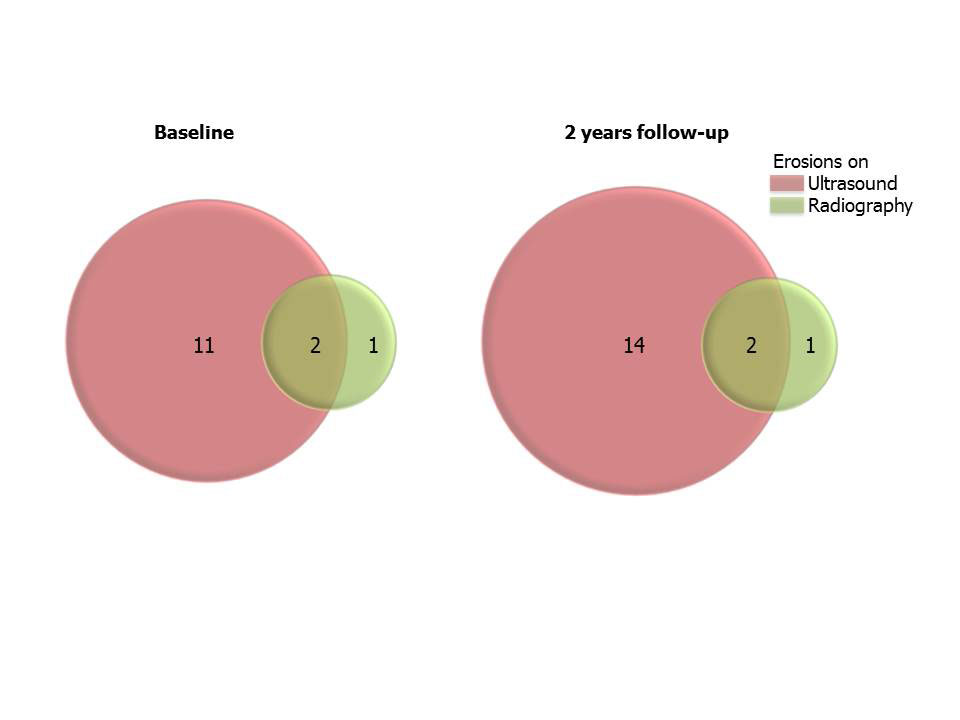Session Information
Session Type: Poster Session (Sunday)
Session Time: 9:00AM-11:00AM
Background/Purpose: Circulating anti-citrullinated protein antibodies (ACPA) are associated with an increased risk of developing rheumatoid arthritis (RA), particularly in patients with erosive disease. We previously showed that erosions detected by ultrasound predict arthritis development in ACPA-positive patients with musculoskeletal (MSK) pain. We now aimed to compare ultrasound with conventional radiography to detect joint erosions during 2 years follow-up of ACPA positive patients with MSK pain.
Methods: We prospectively followed 82 ACPA-positive patients with MSK pain without arthritis at baseline clinical examination. Ultrasound at baseline and after 2 years assessed joint erosions, defined as intraarticular discontinuity of the bone surface visible in 2 planes, in 36 joints in hands and feet. Radiographs of hands and feet were taken at baseline and after 2 years, and evaluated by experienced radiologists according to clinical routine. In cases where erosions had been identified by the radiologist, and in all cases with indistinct findings as well as the radiographs of all patients with erosions by ultrasound, the radiographs were reevaluated by an experienced rheumatologist to confirm presence of erosions. We used Fisher’s exact test to compare the prevalence of erosions as evaluated by ultrasound and radiography.
Results: Baseline joint erosion(s) were detected in 13 (16%) patients by ultrasound and in 3 (4%) patients by conventional radiography (p=0.016, Fig. 1). After 2 years follow-up, 30 of the patients (37%) had developed clinical arthritis. By ultrasound, erosion(s) were detected in 16 patients (19%) and in 3 (4%) by conventional radiography (p=0.018, Fig. 1). During follow-up, the total number of ultrasound erosions had increased from 16 to 20, while radiographic erosions had increased from 3 to 5 (p >0.05). Development of new erosions at 2 years occurred in 8 patients (12%) as evaluated by ultrasound, and in one patient (1%) by radiography (p=0.013) among patients without baseline erosions (by corresponding imaging techniques). In 5 out of the 13 patients (38%) with baseline ultrasound erosions, no further abnormality was detected at 2 years. The corresponding finding concerning radiographic erosion was made in 1 patient.
Conclusion: Ultrasound is more sensitive compared to conventional radiography to detect erosive abnormalities during follow-up of an ACPA-positive at-risk population. To some extent, erosive joint abnormalities show dynamic, and possibly reversible, features in very early phases of RA.
« Back to 2019 ACR/ARP Annual Meeting
ACR Meeting Abstracts - https://acrabstracts.org/abstract/ultrasound-is-more-sensitive-compared-to-conventional-radiography-to-detect-joint-erosions-in-acpa-positive-patients-with-musculoskeletal-pain/

